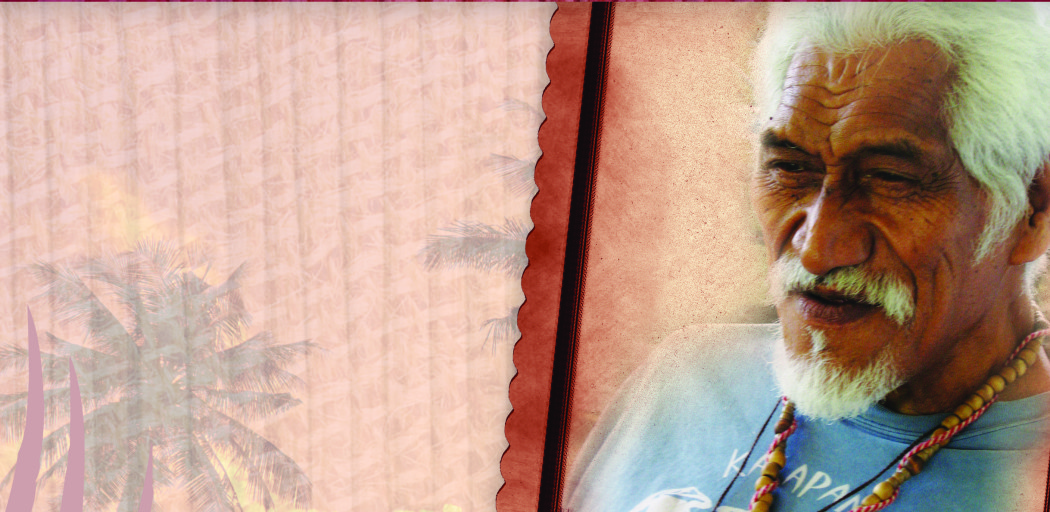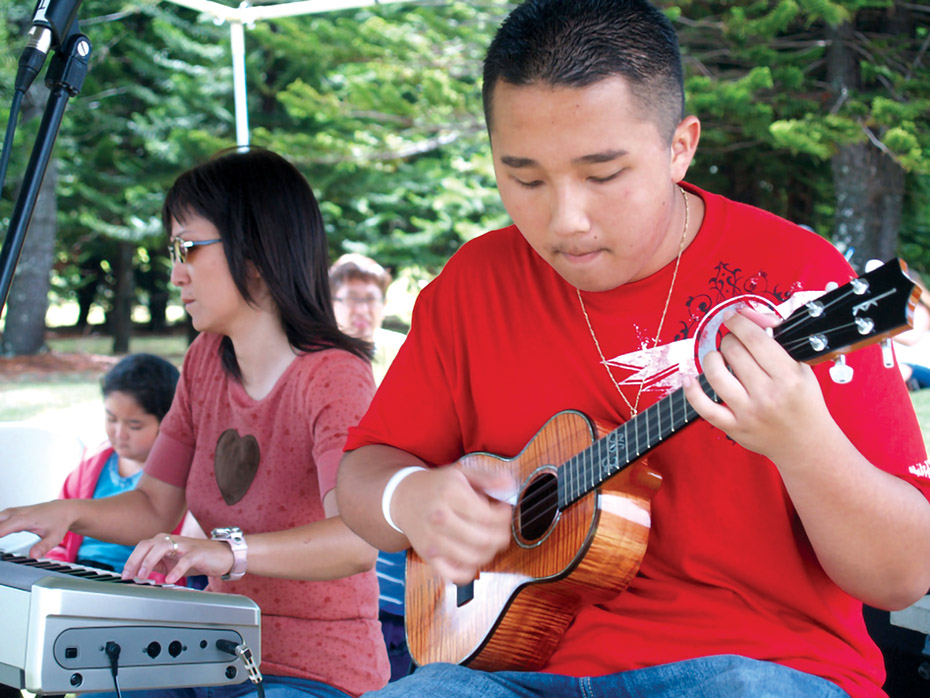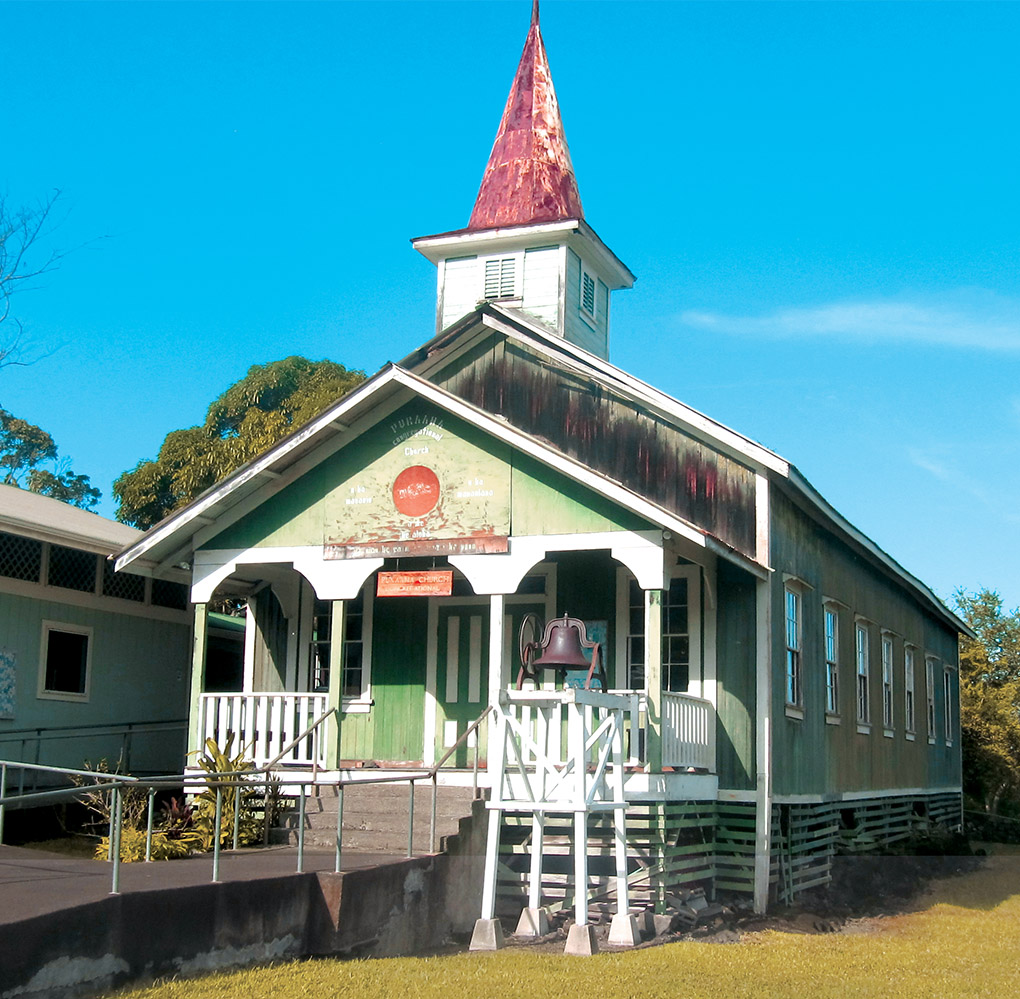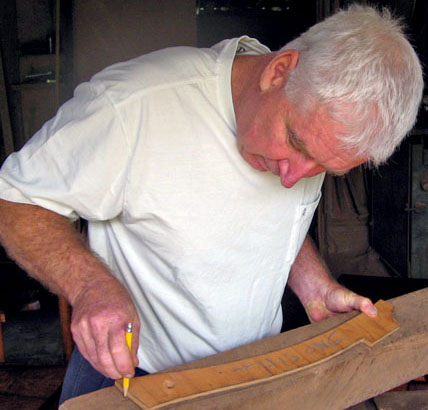
Talking Story with Uncle Robert: Revered Puna Kupuna Holds Court at the End of the Road
 By Denise Laitinen
By Denise Laitinen
If you live in Puna, chances are you know where to find Uncle Robert’s. No need for directions—everyone knows that his family’s four-acre compound can be found at the end of Kapoho-Kalapana Road. The site of Uncle Robert’s Kava Bar, Kalapana Cultural Tours, and a popular farmers market (see sidebar), Uncle Robert’s is a well-known community gathering place.
And while just about everyone knows Uncle Robert’s name, fewer know the man himself. Family patriarch, Hawaiian sovereignty activist, former soldier, sustainable farmer and retired county employee, Robert Keli‘iho‘omalu is a man of great faith who embodies the spirit of aloha.
“Everything about Uncle Robert is about aloha,” says Garry Hoffeld, a retired building contractor who has lived in the area for 15 years. “He is definitely our biggest kupuna,” adds Hoffeld. “There’s others, but he is definitely the most notable,” adds Garry’s wife Cyd.
At 73, Robert Keli‘iho‘omalu has seen many changes in Kalapana. Born in 1939 to a Hawaiian father and Hawaiian/Filipino mother, Robert’s family moved from Mokohulu (in lower Puna) to Kaimū in 1955.
“Growing up those days was real country,” says Uncle Robert. His family raised pigs and grew their own vegetables. Known for being quiet and serene today, the Kalapana area was even quieter back then. “We hardly heard any cars passing by,” he says. “We saw maybe five or six cars a day.”
“We didn’t have electricity, we had kerosene lamps for lights,” he adds. No electricity also meant no refrigerator (or “icebox”). “We ate dried fish and salted meat,” he says.
Uncle Robert points out that in those days the road from Kalapana to Pahoa was gravel, not the nice paved thoroughfare it is today. Going to the nearest school in Pahoa meant a nine-mile ride each way on the rough, winding road.
“Those days our bus was a truck with chicken coop screening all the way around it,” says Uncle Robert. But far from seeing the long trek as a burden, he says he and his friends passed the time with music. “There was always a lot of music and singing on the bus. We would sing Hawaiian songs every day. We had a lot of fun.”
After graduating Pahoa High School in 1958, Keli‘iho‘omalu joined the Army and was stationed overseas in Germany. Four years later, when his tour of duty ended, he returned to Kalapana to care for his mother.
He returned to a changing Hawai‘i. The road to Pahoa had been paved. There were more cars on the road. Hawai‘i had become, officially, the 50th U.S. state. And life was changing for Uncle Robert, as well. Updated utilities were spreading across the island and the family bought a refrigerator.
The same year he was discharged from the Army, he married Philmen Tolentino, a Maui girl from Hana. A singer and songwriter, Philmen worked as a tutor at Pahoa Elementary School. Together they raised 11 children: eight boys (Robert Jr., Sam, Patrick, Primo, Paul, Prince, Phillip and Peter) and three girls (Patricia, Princess, and Lohelani Philmen).
With the exception of Robert Jr. and Sam, who was named after his grandfather, all of Uncle Robert’s sons’ names begin with the letter “p”. Uncle Robert says he named his son Primo because he ran out of names that began with the letter “p”. Shortly after Primo was born he saw a can of Primo beer and decided that would be a pretty good boy’s name.
Just as Uncle Robert spent his youth singing with friends to pass the time, music was a natural part of his children’s lives.
“Both my Mom and Dad were musical,” says Prince Keli‘iho‘omalu. “We all had to sing as kids,” he adds chuckling. Indeed, the family includes several talented musicians and several of Uncle Robert’s sons and grandsons can be heard performing at the farmers market. “The whole family is well known for their music,” says Hoffeld.
While music is important to Uncle Robert, he pursued other career choices. When he returned to Hawai‘i in the early 1960s, he found work as a truck driver with Jas W. Glover. After five years with Glover, he spent another five years working for the County Parks and Recreation Department before transferring to Public Works, where he worked for another two decades.
But even the county bulldozers could not protect Kalapana from the onslaught of lava that devastated the community in 1990. Most of Kalapana and parts of Kaimū were overrun with lava. Uncle Robert’s home, however, was spared.
He recalls the fateful days when the lava flow steamed toward his house. “It was hard not knowing where the lava was going to go,” he says. A deeply religious man, Uncle Robert placed a scapular (a religious sacramental in the Catholic church often worn with a rosary) on the rock wall near the front of his house just before he evacuated his family to safety. After they were evacuated, Uncle Robert’s wife would come to the property on a daily basis to check the status of the lava flow while Uncle Robert was at work. One day he came to get her and found her standing in the yard in tears.
“The heat was so intense from here to there,” he says pointing to two spots only a few feet from each other. She said to me, ‘The lava stopped right in front of me. I was praying and crying and the lava stopped and turned direction.’” Uncle Robert responded, “God has answered your prayer,” to which she replied ‘Thank God…it was a miracle.’”
Sure enough, the lava stopped short, just shy of his family’s home and turned direction heading toward the ocean. Twenty years later you can still see where the lava flow stopped and changed direction. (It’s on the makai side of the stage of the farmers market.)
Uncle Robert and the community as a whole was in for some tough times. Even as they dealt with the destruction, they had to deal with members of the public viewing the situation as a tourist attraction. “We had to put up with the public,” he recalls. “ ”A lot of people were trying to sneak in.”
Although his house was spared, the family spent the next couple of years living with his brother’s family in Mokohulu. “It was about two-and-a-half to three years before they cleared the road and we could move home.” Many had no homes to return to.
A strong proponent of Hawaiian sovereignty, to this day Uncle Robert is critical of the response by the Office of Hawaiian Affairs (OHA) to the devastation that many Hawaiians in Kalapana experienced. “OHA and DHHL—they didn’t help. They should have been in there helping, but we got nothing.”
After the family was able to move back into their home, Uncle Robert decided to open a small place near the front of his property that sold shave ice, soda, and other sundries. He and one of his sons made a trail nearby to show people Hawaiian plants in the area. With the encouragement of a family friend, he decided to start selling kava and opened Uncle Robert’s Awa Bar. Originally open just on the weekends, another family friend offered to run the business on weekdays.
Over the years, the site has become a community gathering place, with different organizations holding everything from veterans’ events to political candidate forums.
“I think he really brings the community together and creates a real sense of family,” says Tracey Kauahi, a Kea‘au resident who, along with her husband Grant, recently held a fundraiser for the Kalapana Canoe Club at the farmers market. “He’s Mr. Aloha,” adds her husband.
Today, Uncle Robert’s extended ‘ohana includes 33-grandchildren and four great-grandchildren. Most of Uncle Robert’s grown children still live in Kalapana, as do 20 of his 33 grandchildren. In fact, about 30 extended family members live in multiple houses on the family compound.
The passage of time has continued to bring changes. Uncle Robert retired from working for the county of Hawai‘i, and in 1996 Philmen, his wife of more than 30 years, passed away. This past February his son Patrick “Puna,” a well-known gifted musician, passed away.
But, as some things change, others remain the same.
Just as Uncle Robert’s parents grew their own food when he was a boy, generations later his family continues to live off the land. The property has an orange grove, a vegetable garden, fruit trees, multiple taro patches—it even houses an apiary and a chicken coop tended to by a family friend who sells honey and eggs at local farmers markets. Sustainable agriculture and buying local produce have come into vogue.
Creating a farmers market was a natural extension for Uncle Robert’s sons. In recent years his sons Prince, Primo, and Sam moved back to Kalapana. Sam had the idea for the farmers market and, given the family’s musical talent, wanted to also incorporate music. Last summer he got the project rolling when he set about building a stage. The year before, two of Uncle Robert’s grandsons started Kalapana Cultural Tours at the same location, offering bike, boat, fishing and hunting tours of the area.
Soon, brothers Prince and Primo joined in helping create the farmers market. Like everything at Uncle Robert’s, the effort to create the market was a communal one. His family is quick to point out that many friends donated materials for the market and that their kōkua (help) made everything possible.
“I’d like to thank all the people that put their hands together to help,” says Uncle Robert, noting that good family friends Jay Luhan, Norman, and Tracy contributed their time and energy.
Grateful that his family is picking up where he left off, Uncle Robert prefers to spend his days in the background. But he is not spending his time alone; his fiancée, Koko Kawauchi, is often by his side. Originally from Japan, Koko says the two met three years ago at his house and a friendship ensued.
Looking to the future, Uncle Robert says he would like people in Kalapana (and beyond) to carry on the aloha spirit. He would like to see everyone band together and help each other, especially in these hard economic times.
And he wants people to know that Kalapana is still a place where the aloha spirit is strong. “There’s no pilikia (trouble), everyone is in harmony. There’s no division, with people looking down on each other, there’s no high or low. That’s the way I believe our Lord wants it to be.”
Uncle Robert’s Farmers Market: A Taste of Old Hawai‘i
Judging from the size of the crowd, Uncle Robert’s Farmers Market is the worst kept secret in lower Puna. Held every Wednesday night from 5-9 p.m. at Uncle Robert’s in Kaimū, Kalapana, it’s the only nighttime farmers market on the island. It’s also one of the busiest. With vendors offering locally grown produce, baked goods, hand made jewelry, freshly cooked food, and live music, it feels more like a festival than a market.
“I don’t call it a farmers market, I call it a social market,” says Ikaika Marzo, one of Uncle Robert’s hānai grandchildren, as he looks across the crowd. Long, communal picnic tables in the dining pavilion are filled with people listening to the Kalapana Awa band perform and enjoying food from one of the many vendors at the market. A little girl is on the dance floor trying to dance hula to the music.
Beyond the picnic tables, throngs of people can be seen strolling the aisles of the farmers market, admiring the produce and wares available.
“It’s a family place,” says Sam Keli‘iho‘omalu, one of Uncle Robert’s 11 children. “It’s a fun place.”
It’s reminiscent of old Hawai‘i, and that’s the way we like to keep it,” says Prince Keli‘iho‘omlau, another one of Uncle Robert’s sons. “It’s very local, very relaxed.”
Situated on Uncle Robert’s four-acre family compound at the end of Kapoho-Kalapana Road in Kaimū, the site was already home to Uncle Robert’s Awa Bar and the starting point for Kalapana Cultural Tours (operated by Marzo and Andrew Keli‘iho‘omalu, one of Uncle Robert’s grandsons) when Uncle Robert’s son Sam decided to establish the market.
The market is truly a family affair and many of Uncle Robert’s extended family can be found working either behind a booth counter, directing traffic and parking, or up on stage performing.
“The majority of people that come down here have jobs, so we decided to have the market at night,” adds Marzo.
Upon opening at the start of this year, the market was an instant success. Within six months there was a waiting list of vendors wanting to participate. Some of the vendors, like Tina Aiona, are related to Uncle Robert (she is his niece), while many others are area residents looking to supplement their income, or just make an income.
Vendor Dave Cardall says he’s a house painter by profession but work has been hard to come by with the recession, so he started a second career creating custom jewelry. The market gives him an opportunity to showcase his wares. “I’m reinventing myself,” he says with a smile.
“We’re pretty much making our own economy down here,” says Marzo.
The market is about more than food and music. It also features a permanent display depicting information on the history of the area with pictures from the 1990 lava flow.
There’s also extensive information displayed about the Hawaiian sovereignty movement, something dear to Uncle Robert Keli‘iho‘omalu’s heart and soul. “Everything about Uncle Robert is about sovereignty,” says Garry Hoffeld, the island-wide organizer for Moku o Keawe Reinstated Lawful Hawaiian Government. For visitors and recently arrived residents, the displays are their first, and sometimes only, exposure to these historical and political issues.
The market is also reflective of Uncle Robert’s strong spirit of aloha, attracting residents and visitors alike. “You see a lot of local people and a lot of visitors,” says Lisa Bowring of Aloha Exotics, who sells chocolate-covered chili peppers and strawberries. “It’s a very festive atmosphere.”
“It’s a mini ho’olaule‘a (festival) every Wednesday,” says Kea‘au resident Tracey Kauahi. ❖
Contact writer Denise Laitinen: wahineokekai@yahoo.com
All photos by Denise Laitinen


